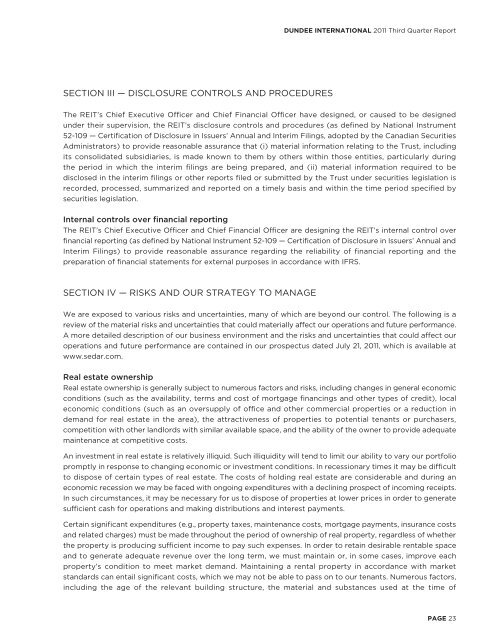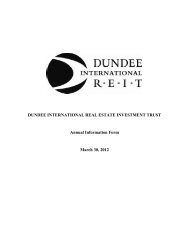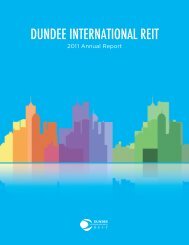DUNDEE INTERNATIONAL REIT
DUNDEE INTERNATIONAL REIT
DUNDEE INTERNATIONAL REIT
Create successful ePaper yourself
Turn your PDF publications into a flip-book with our unique Google optimized e-Paper software.
SECTION III — DISCLOSURE CONTROLS AND PROCEDURES<br />
The <strong>REIT</strong>’s Chief Executive Officer and Chief Financial Officer have designed, or caused to be designed<br />
under their supervision, the <strong>REIT</strong>’s disclosure controls and procedures (as defined by National Instrument<br />
52-109 — Certification of Disclosure in Issuers’ Annual and Interim Filings, adopted by the Canadian Securities<br />
Administrators) to provide reasonable assurance that (i) material information relating to the Trust, including<br />
its consolidated subsidiaries, is made known to them by others within those entities, particularly during<br />
the period in which the interim filings are being prepared, and (ii) material information required to be<br />
disclosed in the interim filings or other reports filed or submitted by the Trust under securities legislation is<br />
recorded, processed, summarized and reported on a timely basis and within the time period specified by<br />
securities legislation.<br />
Internal controls over financial reporting<br />
The <strong>REIT</strong>’s Chief Executive Officer and Chief Financial Officer are designing the <strong>REIT</strong>’s internal control over<br />
financial reporting (as defined by National Instrument 52-109 — Certification of Disclosure in Issuers’ Annual and<br />
Interim Filings) to provide reasonable assurance regarding the reliability of financial reporting and the<br />
preparation of financial statements for external purposes in accordance with IFRS.<br />
SECTION IV — RISKS AND OUR STRATEGY TO MANAGE<br />
<strong>DUNDEE</strong> <strong>INTERNATIONAL</strong> 2011 Third Quarter Report<br />
We are exposed to various risks and uncertainties, many of which are beyond our control. The following is a<br />
review of the material risks and uncertainties that could materially affect our operations and future performance.<br />
A more detailed description of our business environment and the risks and uncertainties that could affect our<br />
operations and future performance are contained in our prospectus dated July 21, 2011, which is available at<br />
www.sedar.com.<br />
Real estate ownership<br />
Real estate ownership is generally subject to numerous factors and risks, including changes in general economic<br />
conditions (such as the availability, terms and cost of mortgage financings and other types of credit), local<br />
economic conditions (such as an oversupply of office and other commercial properties or a reduction in<br />
demand for real estate in the area), the attractiveness of properties to potential tenants or purchasers,<br />
competition with other landlords with similar available space, and the ability of the owner to provide adequate<br />
maintenance at competitive costs.<br />
An investment in real estate is relatively illiquid. Such illiquidity will tend to limit our ability to vary our portfolio<br />
promptly in response to changing economic or investment conditions. In recessionary times it may be difficult<br />
to dispose of certain types of real estate. The costs of holding real estate are considerable and during an<br />
economic recession we may be faced with ongoing expenditures with a declining prospect of incoming receipts.<br />
In such circumstances, it may be necessary for us to dispose of properties at lower prices in order to generate<br />
sufficient cash for operations and making distributions and interest payments.<br />
Certain significant expenditures (e.g., property taxes, maintenance costs, mortgage payments, insurance costs<br />
and related charges) must be made throughout the period of ownership of real property, regardless of whether<br />
the property is producing sufficient income to pay such expenses. In order to retain desirable rentable space<br />
and to generate adequate revenue over the long term, we must maintain or, in some cases, improve each<br />
property’s condition to meet market demand. Maintaining a rental property in accordance with market<br />
standards can entail significant costs, which we may not be able to pass on to our tenants. Numerous factors,<br />
including the age of the relevant building structure, the material and substances used at the time of<br />
PAGE 23






